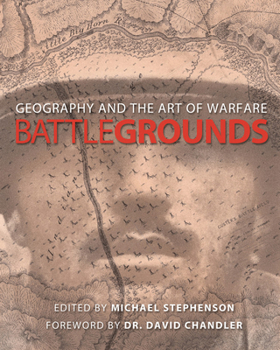Battlegrounds: Geography and the History of Warfare
Select Format
Select Condition 
Book Overview
An analysis of the way in which terrain affects how battles are fought and ultimately how it impacts history provides essays on historical conflicts complemented by vintage and modern maps. This description may be from another edition of this product.
Format:Hardcover
Language:English
ISBN:0792233743
ISBN13:9780792233749
Release Date:September 2003
Publisher:National Geographic Society
Length:288 Pages
Weight:2.30 lbs.
Dimensions:1.0" x 7.4" x 9.6"
Customer Reviews
3 ratings
Geography and Battlegrounds - and real maps!
Published by Thriftbooks.com User , 18 years ago
A book with short story coverage of historic battles needs two things: 1) a coverage of the battle with the applicable geography and it's effect on the combatants, and 2) a map or maps showing the terrain, troop location at battle initiation, movement through the combat phase and troop distribution at combat conclusion. Without all of those, I suppose, a period map showing troop distribution at the start of combat and all of the important sites located on one map is the next best thing. When I first looked at this book, some of the maps appeared nearly useless. The map of the Battle of Cedar Creek in the Shenandoah Campaign was as close to unintelligible as about any I have tried to decypher. As I continued to read the book, however, I was particularly struck by some of the other period maps. There were some awesome inclusions. Iwo Jima and Chancellorsville were two of the many that absolutely provided a picture worth a thousand words. Some showed terrain in shaded relief, some in hachure typical of the period of the battle (one decade (Omdurman, Sudan, 1898) different than another (Gettysburg, 1863 and Balaklava, 1854)), molehills, contours, bathimetrics, monochromatic patterns, and numerous period paintings of troop distribution and terrain. The depth of the discussion varied from battle to battle, but was generally not too deep for some one looking at the geography of the battle and not the planning, logistics, course of the combat phase and the aftermath. I would say the value of the book is the combination of observable geography, the study of combat events and the delightful discovery of a hisory of the evolution of combat maps through the ages.
Gallipoli vs. Yorktown and Bataan
Published by Thriftbooks.com User , 20 years ago
I disagree with the Publishers Weekly review that Gallipoli should be grouped with Yorktown and Bataan for trapped on a peninsula instead of under Coasts. At Gallipoli the British, Australians, and New Zealanders were floundering on the coast trying to get inland, while the Turks were inland trying to repel the incursion. Neither side were trapped on a peninsula. The British could have and eventually had to reembark. At Yorktown the British were trapped on a peninsula and had to surrender. Likewise at Bataan the Americans were trapped on a peninsula and had to surrender.
Balancing the stars
Published by Thriftbooks.com User , 20 years ago
Did the same reader write all the reviews with one star? They sound suspiciously similar.





